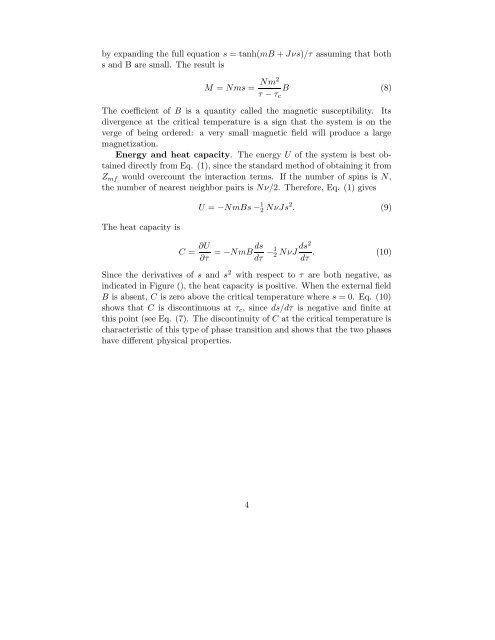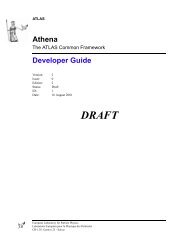Notes on Mean Field Theory
Notes on Mean Field Theory
Notes on Mean Field Theory
You also want an ePaper? Increase the reach of your titles
YUMPU automatically turns print PDFs into web optimized ePapers that Google loves.
y expanding the full equati<strong>on</strong> s = tanh(mB + Jνs)/τ assuming that both<br />
s and B are small. The result is<br />
M = Nms = Nm2<br />
τ − τ c<br />
B (8)<br />
The coefficient of B is a quantity called the magnetic susceptibility. Its<br />
divergence at the critical temperature is a sign that the system is <strong>on</strong> the<br />
verge of being ordered: a very small magnetic field will produce a large<br />
magnetizati<strong>on</strong>.<br />
Energy and heat capacity. The energy U of the system is best obtained<br />
directly from Eq. (1), since the standard method of obtaining it from<br />
Z mf would overcount the interacti<strong>on</strong> terms. If the number of spins is N,<br />
the number of nearest neighbor pairs is Nν/2. Therefore, Eq. (1) gives<br />
The heat capacity is<br />
U = −NmBs − 1 2 NνJs 2 . (9)<br />
C = ∂U<br />
∂τ<br />
= −NmB<br />
ds<br />
dτ −1 2 NνJ ds2<br />
dτ . (10)<br />
Since the derivatives of s and s 2 with respect to τ are both negative, as<br />
indicated in Figure (), the heat capacity is positive. When the external field<br />
B is absent, C is zero above the critical temperature where s = 0. Eq. (10)<br />
shows that C is disc<strong>on</strong>tinuous at τ c , since ds/dτ is negative and finite at<br />
this point (see Eq. (7). The disc<strong>on</strong>tinuity of C at the critical temperature is<br />
characteristic of this type of phase transiti<strong>on</strong> and shows that the two phases<br />
have different physical properties.<br />
4
















